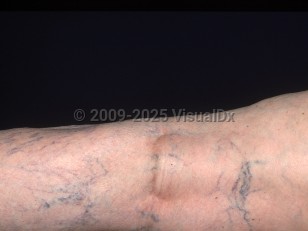Varicosities
Alerts and Notices
Important News & Links
Synopsis

Varicosities are abnormally dilated and tortuous veins that usually appear in the lower extremities. Varicosities in general occur as a result of an underlying problem with reverse venous flow, also known as venous insufficiency syndrome.
Healthy veins have one-way valves that are located at various levels, superficial to deep. They redirect blood in a systematic fashion from the outermost surface of the body toward the center and ultimately to the heart. At each step, these valves prevent backflow of blood. When these valves become incompetent and "leaky," blood back flows; this results in an increase in venous pressure in superficial veins. Since the superficial venous system operates as a low-pressure system, repeated increases in venous pressure result in enlarged and tortuous veins. In essence, varicosities are normal veins that have become dilated because of increased venous pressure set in motion by incompetent valves.
Most commonly, varicosities are either varicose veins or spider veins, which are also known as telangiectases. These varicosities are on the surface and visible. They can be uncomfortable, annoying, or just cosmetically concerning. Normal pregnancies may be complicated by mild-to-severe vulvovaginal varicosities, or vaginal varices, in the second or third trimester.
Deeper varicosities are a sign of more significant problems and can result in serious and chronic conditions if left unrecognized and untreated. For instance, lipodermatosclerosis (LDS), which is associated with fat necrosis and recurrent ulcerations, can be a manifestation of untreated chronic venous insufficiency. In advanced cases of LDS, the proximal part of the lower extremity swells up as a result of the chronic venous obstruction. The distal part of the lower extremity in turn shrinks from all of the chronic ulcerations and fat necrosis. This combination results in an "inverted champagne bottle" appearance of the lower extremity. Occasionally an acute form of LDS can occur, and it is important to not misdiagnose it as cellulitis, inflammatory morphea, or erythema nodosum.
Healthy veins have one-way valves that are located at various levels, superficial to deep. They redirect blood in a systematic fashion from the outermost surface of the body toward the center and ultimately to the heart. At each step, these valves prevent backflow of blood. When these valves become incompetent and "leaky," blood back flows; this results in an increase in venous pressure in superficial veins. Since the superficial venous system operates as a low-pressure system, repeated increases in venous pressure result in enlarged and tortuous veins. In essence, varicosities are normal veins that have become dilated because of increased venous pressure set in motion by incompetent valves.
Most commonly, varicosities are either varicose veins or spider veins, which are also known as telangiectases. These varicosities are on the surface and visible. They can be uncomfortable, annoying, or just cosmetically concerning. Normal pregnancies may be complicated by mild-to-severe vulvovaginal varicosities, or vaginal varices, in the second or third trimester.
Deeper varicosities are a sign of more significant problems and can result in serious and chronic conditions if left unrecognized and untreated. For instance, lipodermatosclerosis (LDS), which is associated with fat necrosis and recurrent ulcerations, can be a manifestation of untreated chronic venous insufficiency. In advanced cases of LDS, the proximal part of the lower extremity swells up as a result of the chronic venous obstruction. The distal part of the lower extremity in turn shrinks from all of the chronic ulcerations and fat necrosis. This combination results in an "inverted champagne bottle" appearance of the lower extremity. Occasionally an acute form of LDS can occur, and it is important to not misdiagnose it as cellulitis, inflammatory morphea, or erythema nodosum.
Codes
ICD10CM:
I83.90 – Asymptomatic varicose veins of unspecified lower extremity
SNOMEDCT:
128060009 – Venous varices
I83.90 – Asymptomatic varicose veins of unspecified lower extremity
SNOMEDCT:
128060009 – Venous varices
Look For
Subscription Required
Diagnostic Pearls
Subscription Required
Differential Diagnosis & Pitfalls

To perform a comparison, select diagnoses from the classic differential
Subscription Required
Best Tests
Subscription Required
Management Pearls
Subscription Required
Therapy
Subscription Required
References
Subscription Required
Last Updated:02/05/2025
 Patient Information for Varicosities
Patient Information for Varicosities
Premium Feature
VisualDx Patient Handouts
Available in the Elite package
- Improve treatment compliance
- Reduce after-hours questions
- Increase patient engagement and satisfaction
- Written in clear, easy-to-understand language. No confusing jargon.
- Available in English and Spanish
- Print out or email directly to your patient
Upgrade Today

Varicosities

